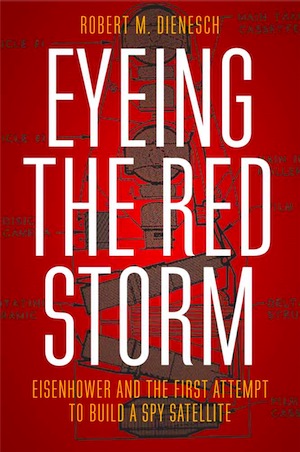Review: Eyeing the Red Stormby Jeff Foust
|
| Eisenhower was motivated to develop spysats by more than simply learning about Soviet bomber deployments to head off a surprise attack. |
Except, though, that while the CORONA satellites were the first to fly, CORONA was not the first spy satellite program. Before CORONA, and even before Sputnik, there was an effort known only by the designation WS-117L. That project, born of a intense need to obtain intelligence about the Soviet Union, may have been ahead of its time, but did pave the way for CORONA and its successors. Historian Robert M. Dienesch shines a spotlight on the murky history of WS-117L in Eyeing the Red Storm.
The motivation to pursue WS-117L, Dienesch notes, was a desire by President Dwight D. Eisenhower for better intelligence about the Soviet Union. Little more than a decade after Pearl Harbor, both he and the country in general were concerned about the threat of a surprise attack, one amplified by the devastation possible with nuclear weapons. The US had limited intelligence of Soviet bomber and missile development efforts; that gap was initially, and infamously, filled for a time by the U-2.
Eisenhower, though, was motivated by more than simply learning about Soviet bomber deployments to head off a surprise attack. That lack of intelligence created a vacuum of information that the military attempted to fill with worst-case scenarios about Russian capabilities, making it appear that the US was falling dangerously behind the Soviets. Military leaders did so to justify their own requests for aircraft, including bombers, to counter that perceived Soviet lead. Eisenhower, though, was often opposed to those lobbying efforts by the military, concerned that high defense spending could ultimately wreck the US economy. Better intelligence, versus speculation, about Soviet capabilities could help rein in those military demands.
Studies early in the Eisenhower Administration suggested that reconnaissance satellites could provide a long-term solution to that desire for better intelligence about Soviet strategic activities. (The U-2 was seen as a short-term stopgap because it flew over Soviet airspace.) That led to work on an Air Force project known a WS-117L to develop such a satellite.
While the first half of the book provides that policy background that resulted in WS-117L, the second half examines the history of WS-117L itself. Much less about WS-117L has been declassified than CORONA (and, doubtless, many of the records have simply been lost), but Dienesch does his best to try and describe the program and its development.
That includes its evolving technical capabilities, as the Air Force and industry struggled to figure out how to build something that had never been built before: a satellite. Initially, the Air Force considered using nuclear power for the spacecraft, until advances in photovoltaics made solar power a feasible alternative. WS-117L also initially ruled out the use of film return capsules, because surviving reentry did not seem viable. However, the low resolution offered by television cameras, the alternative they considered, threatened to make those images almost useless for reconnaissance, pushing the program towards film return.
| Initially, the Air Force considered using nuclear power for the spacecraft, until advances in photovoltaics made solar power a feasible alternative. |
WS-117L also struggled with funding, as it was seen as a lower priority to other efforts, including ICBM development and the Vanguard satellite program. The launch of Sputnik changed that, but at the same time WS-117L evolved. Some time in the year after the launch of Sputnik, WS-117L transitioned from development of a single satellite to three separate satellite programs, including an imaging system called SENTRY (later renamed SAMOS) and a missile warning system, MIDAS. The third was DISCOVERER, which was billed as an R&D program but was in fact the cover for CORONA, the film-return reconnaissance system that was handed over to the CIA. While those programs, and their successors, would live on, WS-117L did not.
Dienesch notes that Eyeing the Red Storm is not a complete history of the WS-117L program: many sources of information remain classified or otherwise unavailable. One key source he used was the memoir of an Air Force captain who helped run the project in the mid-1950s, something that he acknowledges has drawbacks. One disappointment with the book is the lack of illustrations, which may be in part due to the limited information available about WS-117L, but there’s nothing to illustrate other satellite programs, their capabilities, or even the people involved. Despite these limitations, though, the book helps shed new light on a spy satellite program that has long remained in the shadows.
